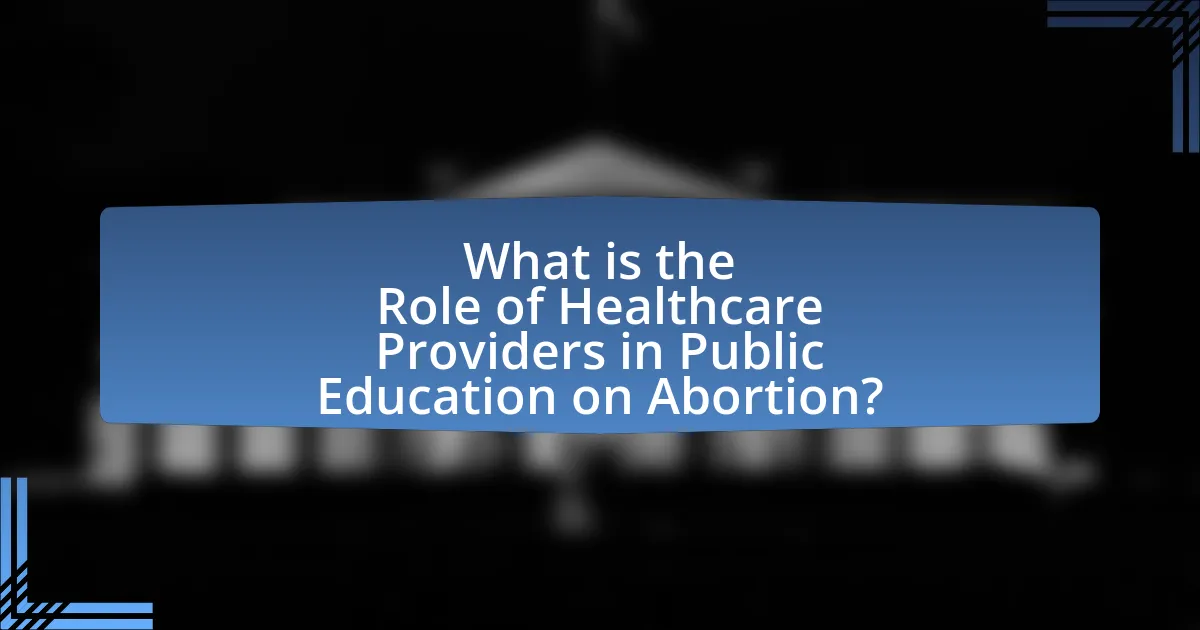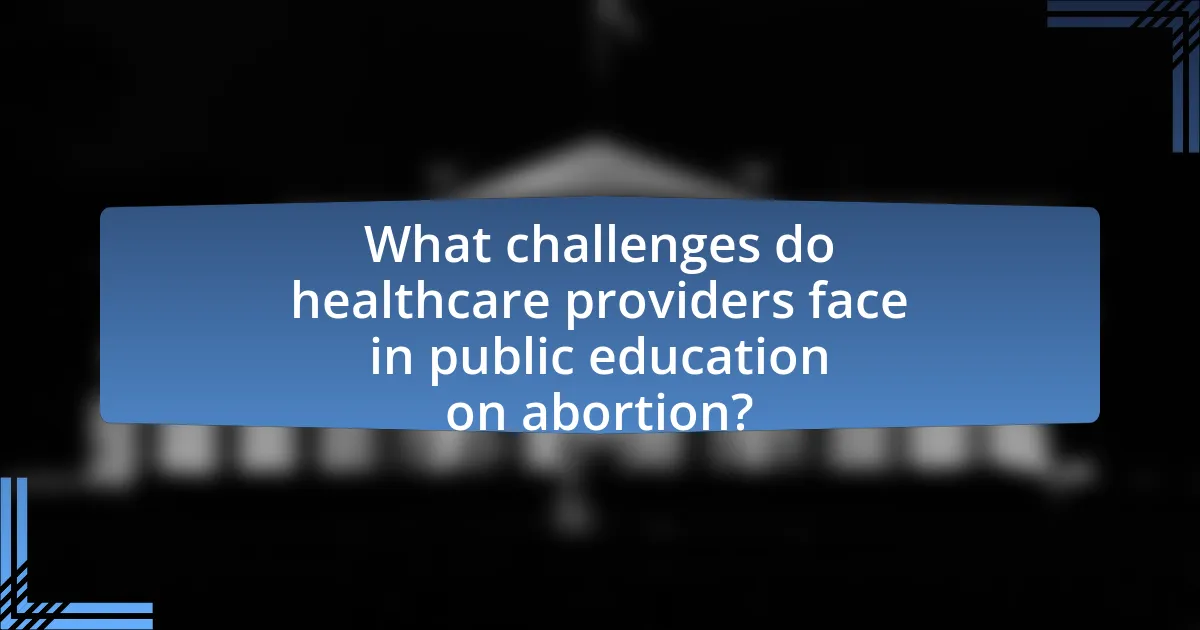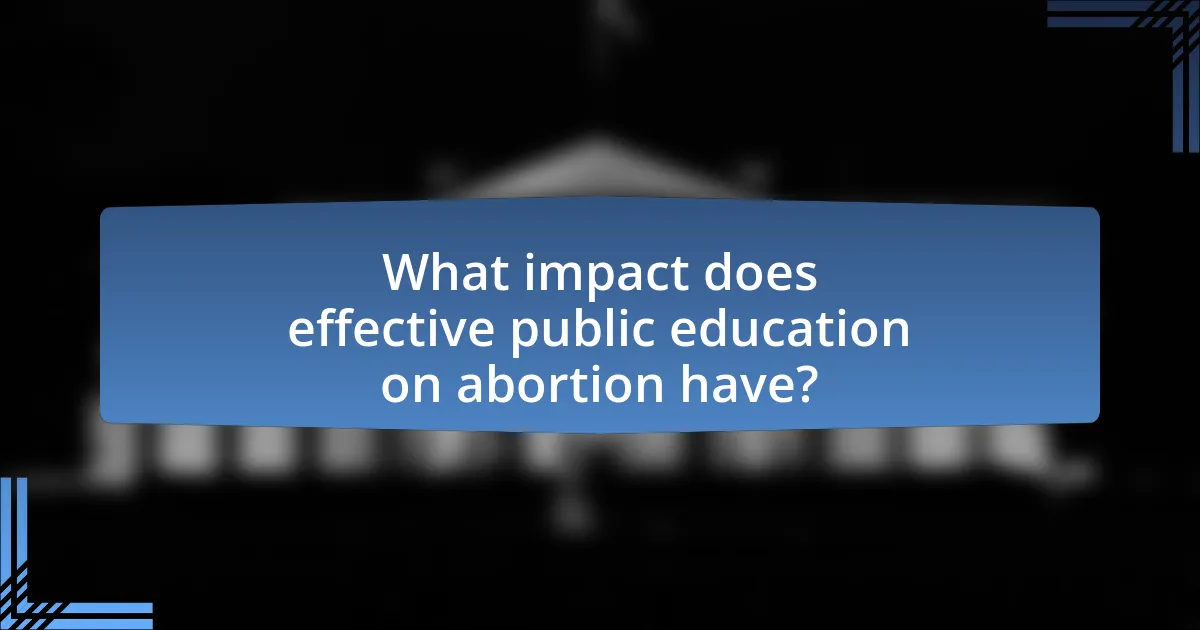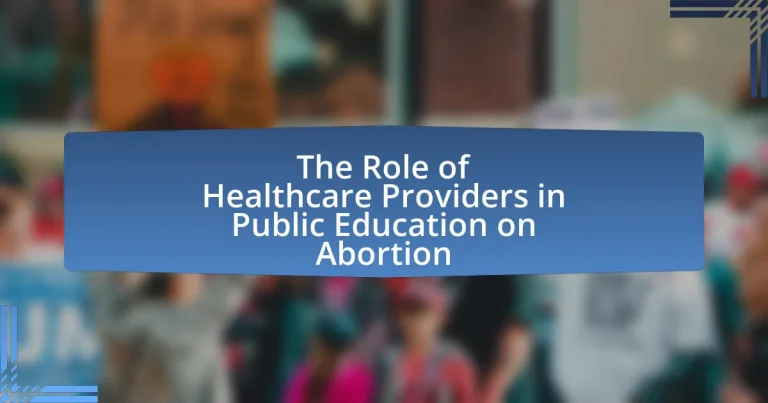Healthcare providers play a vital role in public education on abortion by delivering accurate, evidence-based information that addresses medical, emotional, and legal aspects of the procedure. This article outlines the importance of public education in dispelling myths and reducing stigma, highlighting the impact of misinformation on public perception and decision-making. It discusses the responsibilities of healthcare providers, including the need for ethical considerations and effective communication strategies, as well as the challenges they face, such as stigma and legal restrictions. Additionally, the article emphasizes the significance of community engagement and collaboration with organizations to enhance educational efforts, ultimately contributing to better reproductive health outcomes and informed choices.

What is the Role of Healthcare Providers in Public Education on Abortion?
Healthcare providers play a crucial role in public education on abortion by delivering accurate, evidence-based information to patients and the community. They educate individuals about the medical, emotional, and legal aspects of abortion, helping to dispel myths and reduce stigma associated with the procedure. Research indicates that when healthcare providers engage in public education, it leads to improved understanding and informed decision-making among patients, as evidenced by a study published in the American Journal of Public Health, which found that comprehensive counseling by healthcare professionals significantly increased knowledge about abortion options.
Why is public education on abortion important?
Public education on abortion is important because it equips individuals with accurate information, enabling informed decision-making regarding reproductive health. Access to comprehensive education helps dispel myths and misconceptions surrounding abortion, which can lead to stigma and misinformation. Studies show that states with comprehensive sex education, including information on abortion, have lower rates of unintended pregnancies and abortions, highlighting the effectiveness of informed public discourse. Furthermore, public education fosters a supportive environment for individuals facing reproductive choices, ultimately contributing to better health outcomes and societal understanding.
What are the common misconceptions about abortion that need addressing?
Common misconceptions about abortion include the belief that it is primarily used as a form of contraception, that it poses significant long-term health risks to women, and that it is a simple procedure without emotional or psychological implications. Research indicates that most individuals seeking abortions do so after careful consideration and often due to circumstances such as financial instability or health concerns, rather than as a casual choice. Additionally, studies show that legal abortions performed by qualified healthcare providers are generally safe, with the World Health Organization stating that complications are rare when the procedure is conducted in a safe environment. Furthermore, many individuals experience a range of emotions post-abortion, which can include relief, sadness, or guilt, highlighting the need for comprehensive emotional support and counseling. Addressing these misconceptions is crucial for informed public discourse and effective healthcare education.
How does misinformation impact public perception of abortion?
Misinformation significantly distorts public perception of abortion by fostering misconceptions about its safety, legality, and ethical implications. For instance, studies indicate that false claims about the physical risks associated with abortion can lead to increased fear and stigma, influencing individuals’ attitudes and decisions regarding reproductive health. Research published in the journal “Health Affairs” highlights that misinformation can create a polarized environment, where individuals are less likely to seek accurate information from healthcare providers, thereby undermining informed decision-making. This distortion not only affects personal choices but also shapes broader societal attitudes and policies related to abortion.
What responsibilities do healthcare providers have in this context?
Healthcare providers have the responsibility to deliver accurate, evidence-based information about abortion to patients and the public. This includes educating individuals on the medical, legal, and emotional aspects of abortion, ensuring that patients understand their options and the potential risks involved. Providers must also advocate for access to safe abortion services and support informed decision-making by offering non-judgmental counseling. According to the World Health Organization, healthcare providers play a crucial role in reducing stigma and misinformation surrounding abortion, which is essential for public health and patient autonomy.
How can healthcare providers ensure accurate information dissemination?
Healthcare providers can ensure accurate information dissemination by utilizing evidence-based guidelines and engaging in continuous education. By adhering to established clinical guidelines, such as those from the American College of Obstetricians and Gynecologists, healthcare providers can present reliable information regarding abortion procedures, risks, and benefits. Continuous education through professional development and training ensures that providers remain updated on the latest research and best practices, which is crucial for maintaining accuracy. Furthermore, employing clear communication strategies, including the use of plain language and culturally sensitive materials, enhances understanding among diverse populations. This approach is supported by studies indicating that effective communication improves patient comprehension and trust, ultimately leading to better health outcomes.
What ethical considerations must healthcare providers keep in mind?
Healthcare providers must keep patient autonomy, beneficence, non-maleficence, and justice in mind as ethical considerations. Patient autonomy emphasizes the right of individuals to make informed decisions about their own healthcare, which is particularly crucial in discussions surrounding abortion. Beneficence requires providers to act in the best interest of the patient, ensuring that they receive appropriate care and support. Non-maleficence obligates healthcare providers to avoid causing harm, which includes providing accurate information and avoiding coercive practices. Lastly, justice involves ensuring equitable access to healthcare services, including abortion, regardless of socioeconomic status or background. These ethical principles guide healthcare providers in delivering responsible and respectful care in the context of abortion education and services.
How do healthcare providers engage with the community on abortion education?
Healthcare providers engage with the community on abortion education through outreach programs, workshops, and informational sessions. These initiatives aim to provide accurate information about abortion options, procedures, and reproductive health. For instance, studies show that community-based education efforts can significantly improve knowledge and reduce stigma surrounding abortion, as evidenced by a 2018 report from the Guttmacher Institute, which highlighted that comprehensive education initiatives led to increased understanding of reproductive rights among participants. Additionally, healthcare providers often collaborate with local organizations to reach diverse populations, ensuring that education is culturally sensitive and accessible.
What methods do healthcare providers use to educate the public?
Healthcare providers use various methods to educate the public, including community outreach programs, informational workshops, social media campaigns, and distribution of educational materials. Community outreach programs often involve partnerships with local organizations to host events that provide information on abortion services and reproductive health. Informational workshops allow healthcare professionals to engage directly with individuals, answering questions and dispelling myths surrounding abortion. Social media campaigns leverage platforms like Facebook and Twitter to disseminate accurate information quickly and widely, reaching diverse audiences. Additionally, healthcare providers distribute brochures, pamphlets, and online resources that offer factual information about abortion procedures, options, and support services, ensuring that the public has access to reliable data.
How can healthcare providers collaborate with other organizations for effective education?
Healthcare providers can collaborate with other organizations for effective education by forming partnerships that leverage shared resources and expertise. For instance, healthcare providers can work with non-profit organizations, educational institutions, and community groups to develop comprehensive educational programs on abortion. These collaborations can include joint workshops, informational campaigns, and resource sharing, which enhance the reach and impact of educational efforts. Research indicates that such partnerships can improve public understanding and reduce stigma, as evidenced by initiatives like the “Abortion Care Network,” which successfully combines efforts from various stakeholders to promote accurate information and support services.

What challenges do healthcare providers face in public education on abortion?
Healthcare providers face significant challenges in public education on abortion, primarily due to misinformation and stigma surrounding the topic. Misinformation can lead to public misconceptions about the safety and legality of abortion, which healthcare providers must actively counteract through accurate information dissemination. Stigma, often rooted in cultural and religious beliefs, can hinder open discussions about abortion, making it difficult for providers to engage with the community effectively. Additionally, legal restrictions in various regions can limit the ability of healthcare providers to share comprehensive information about abortion services, further complicating their educational efforts. These challenges necessitate a strategic approach to public education that addresses both misinformation and stigma while navigating legal constraints.
What barriers exist in communicating abortion-related information?
Barriers in communicating abortion-related information include stigma, misinformation, and legal restrictions. Stigma surrounding abortion often leads to fear of judgment, causing individuals to avoid seeking or sharing accurate information. Misinformation proliferates through social media and other channels, resulting in confusion and misunderstanding about abortion services and options. Legal restrictions, such as laws limiting the dissemination of abortion-related information by healthcare providers, further complicate communication efforts. For instance, in some regions, healthcare professionals face penalties for providing comprehensive information about abortion, which hinders their ability to educate the public effectively.
How do cultural and societal attitudes affect healthcare providers’ efforts?
Cultural and societal attitudes significantly influence healthcare providers’ efforts by shaping their interactions with patients and the community. For instance, providers may face challenges in delivering comprehensive abortion education and services in environments where stigma and misinformation prevail, leading to hesitance in discussing options openly. Research indicates that in regions with strong anti-abortion sentiments, healthcare professionals often encounter barriers such as limited resources and support, which can hinder their ability to provide accurate information and care. A study published in the American Journal of Public Health found that healthcare providers in conservative areas reported feeling pressured to conform to local beliefs, impacting their willingness to advocate for reproductive health services. Thus, cultural and societal attitudes directly affect the effectiveness and accessibility of healthcare providers’ efforts in public education on abortion.
What legal restrictions impact the education provided by healthcare professionals?
Legal restrictions impacting the education provided by healthcare professionals include state laws that limit the dissemination of information regarding abortion procedures, counseling, and referrals. For instance, some states have enacted laws that require healthcare providers to present biased information or to withhold certain medical facts about abortion, which directly affects the quality and comprehensiveness of education offered to patients. Additionally, regulations may impose penalties on healthcare professionals who provide information that contradicts state-mandated narratives, thereby creating a chilling effect on open dialogue and education regarding reproductive health. These legal frameworks can significantly restrict the ability of healthcare providers to educate patients fully and accurately about their options.
How can healthcare providers overcome these challenges?
Healthcare providers can overcome challenges in public education on abortion by enhancing communication strategies and fostering community engagement. Effective communication involves using clear, evidence-based information to address misconceptions and stigma surrounding abortion. For instance, studies show that when healthcare providers engage in open dialogues with patients and the community, it significantly increases understanding and reduces misinformation. Additionally, collaborating with local organizations can help healthcare providers reach diverse populations, ensuring that educational efforts are culturally sensitive and accessible. This approach not only builds trust but also empowers individuals to make informed decisions regarding their reproductive health.
What strategies can be implemented to improve public education efforts?
To improve public education efforts, healthcare providers can implement community outreach programs that focus on accurate information dissemination regarding abortion. These programs can include workshops, informational sessions, and partnerships with local organizations to reach diverse populations. Evidence shows that targeted educational initiatives can significantly increase knowledge and reduce stigma; for instance, a study published in the American Journal of Public Health found that community-based education led to a 30% increase in understanding of reproductive health issues among participants. By utilizing evidence-based strategies and engaging with the community, healthcare providers can enhance public education efforts effectively.
How can healthcare providers advocate for better policies regarding abortion education?
Healthcare providers can advocate for better policies regarding abortion education by actively participating in policy discussions, collaborating with advocacy organizations, and providing evidence-based information to policymakers. Engaging in local and national forums allows healthcare providers to voice the importance of comprehensive abortion education, which is supported by research indicating that informed patients make better health decisions. For instance, a study published in the American Journal of Public Health found that access to accurate information about abortion significantly reduces stigma and misinformation. By leveraging their expertise and the latest research, healthcare providers can influence policy changes that promote better educational resources and access to abortion services.

What impact does effective public education on abortion have?
Effective public education on abortion significantly reduces misinformation and stigma surrounding the procedure. By providing accurate information about reproductive health, healthcare providers can empower individuals to make informed decisions, leading to improved health outcomes. Studies indicate that comprehensive sex education, which includes information about abortion, correlates with lower rates of unintended pregnancies and abortions. For instance, research published in the American Journal of Public Health found that states with comprehensive sex education programs have lower rates of teen pregnancies compared to those with abstinence-only programs. This demonstrates that effective public education not only informs but also positively influences public health metrics related to abortion.
How does public education influence abortion rates and health outcomes?
Public education significantly influences abortion rates and health outcomes by providing individuals with essential information about reproductive health, contraception, and the implications of abortion. Comprehensive public education programs that include accurate sexual health information have been shown to reduce unintended pregnancies, which in turn lowers abortion rates. For instance, research published in the American Journal of Public Health indicates that states with comprehensive sex education programs experience lower rates of teenage pregnancies and abortions compared to those with abstinence-only education. Furthermore, public education initiatives that promote access to healthcare services and contraception contribute to improved health outcomes by ensuring that individuals can make informed choices regarding their reproductive health.
What evidence supports the effectiveness of education in reducing stigma around abortion?
Education effectively reduces stigma around abortion by increasing knowledge and understanding of the procedure and its implications. Research indicates that comprehensive sex education programs, which include information about abortion, lead to more positive attitudes towards individuals who seek abortions. For instance, a study published in the journal “Perspectives on Sexual and Reproductive Health” found that individuals who received education on reproductive health, including abortion, demonstrated lower levels of stigma and more supportive attitudes towards abortion access. Additionally, community-based educational interventions have shown to foster empathy and reduce misconceptions about abortion, further supporting the notion that informed individuals are less likely to hold stigmatizing views.
How can improved education lead to better reproductive health choices?
Improved education leads to better reproductive health choices by equipping individuals with knowledge about their bodies, contraceptive options, and the implications of reproductive decisions. Comprehensive sexual education programs have been shown to increase awareness of reproductive health issues, reduce rates of unintended pregnancies, and empower individuals to make informed choices. For instance, a study published in the Journal of Adolescent Health found that adolescents who received comprehensive sex education were 50% less likely to experience an unintended pregnancy compared to those who did not receive such education. This evidence underscores the critical role that education plays in fostering informed decision-making regarding reproductive health.
What role do healthcare providers play in shaping public policy on abortion education?
Healthcare providers play a crucial role in shaping public policy on abortion education by offering expert knowledge and evidence-based information that informs legislative decisions. Their clinical experience allows them to advocate for policies that prioritize patient health and safety, ensuring that educational materials reflect current medical standards and practices. For instance, healthcare providers often participate in public forums, contribute to policy discussions, and collaborate with advocacy groups to promote comprehensive reproductive health education. Research indicates that states with more healthcare provider involvement in policy-making tend to have more informed and supportive abortion education initiatives, highlighting the impact of their expertise on public policy outcomes.
How can healthcare providers contribute to policy discussions and reforms?
Healthcare providers can contribute to policy discussions and reforms by leveraging their expertise and firsthand experience to inform evidence-based practices. They can participate in advocacy efforts, engage in public forums, and collaborate with policymakers to ensure that healthcare policies reflect the realities of patient care and public health needs. For instance, studies have shown that healthcare professionals who engage in advocacy can significantly influence legislative outcomes, as seen in the American Medical Association’s involvement in shaping healthcare policies. Their insights can help bridge the gap between clinical practice and policy, ultimately leading to more effective and equitable healthcare reforms.
What examples exist of successful advocacy by healthcare providers in this area?
Successful advocacy by healthcare providers in public education on abortion includes initiatives like the American College of Obstetricians and Gynecologists (ACOG) launching campaigns to inform the public about safe abortion practices and the importance of access to reproductive healthcare. ACOG’s “Abortion is Essential Healthcare” campaign effectively highlighted the medical necessity of abortion services, leading to increased awareness and support among the public and policymakers. Additionally, healthcare providers in various states have collaborated with organizations like Planned Parenthood to conduct community outreach programs that educate individuals about reproductive rights and available services, resulting in improved access to care and informed decision-making for patients.
What best practices should healthcare providers follow in public education on abortion?
Healthcare providers should prioritize evidence-based information, clear communication, and cultural sensitivity in public education on abortion. Evidence-based information ensures that the content shared is accurate and reflects current medical guidelines, such as those from the American College of Obstetricians and Gynecologists, which advocate for comprehensive reproductive health education. Clear communication involves using straightforward language that is accessible to diverse audiences, thereby enhancing understanding and reducing stigma. Cultural sensitivity is crucial, as it acknowledges and respects the varied beliefs and values surrounding abortion, which can differ significantly among communities. By integrating these best practices, healthcare providers can effectively educate the public, promote informed decision-making, and support individuals in navigating their reproductive health options.


